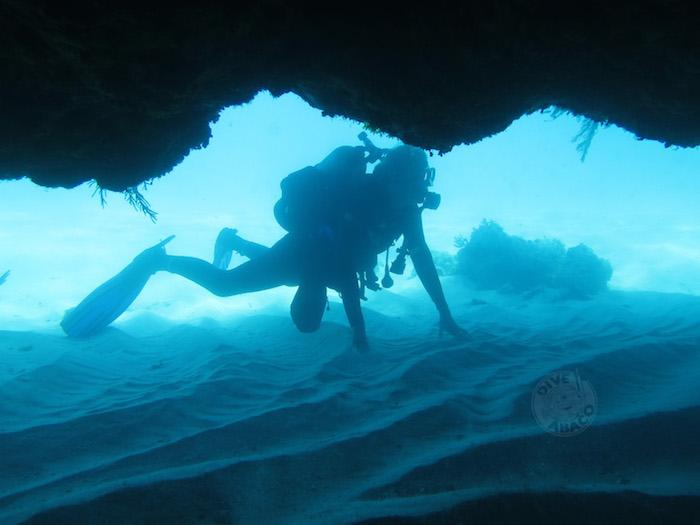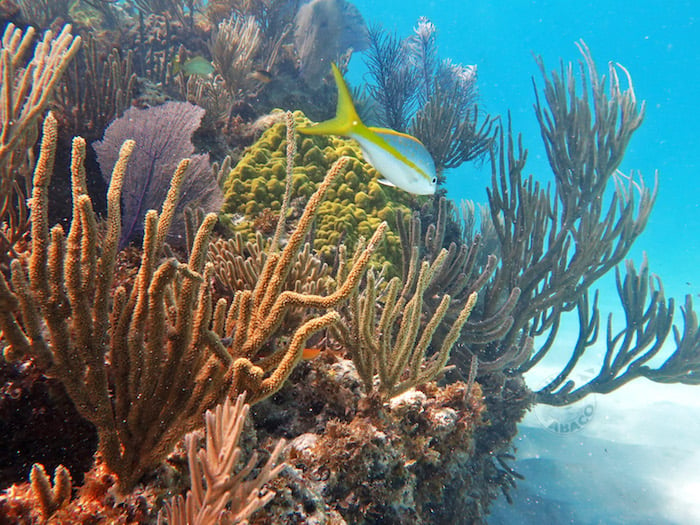To me, a rather novice scuba diver, the waves rolling across Fowl Cays National Park in the Bahamas looked a little big. We had motored out of Marsh Harbor on Abaco at exactly 9:30 a.m., blue skies doing nothing to distract me from the growing anxiety in the pit of my stomach. Water quality looked good, and as we prepared our equipment it was easy to see the large reef beneath the surface. Apprehension now mixed with pure excitement.
I had trained as an open water diver over a year before, completing two dives in calm currents off the Gulf of Mexico in Destin, Florida. Now aboard Dive Abaco’s boat, under the guidance of Captain Keith Rogers, I was preparing to descend 25- 30 feet to follow Rogers as we circled the reef counter-clockwise.
This was a family dive, and my mother, brother, and husband were diving as well. On the surface, my father, sister, grandmother, brother’s friend, and sister’s boyfriend were preparing their snorkels for a much shallower swim. Of the four of us with tanks strapped to our backs, I had the least amount of experience, and my husband (a former Navy diver) made sure to check my equipment before I hoisted the heavy scuba rig onto my back. Was I still nervous? Definitely, but I wasn’t going to let my little brother know (he’s 6’2 and 21 years old, but he’ll always be my little brother). So without further ado, I faced the water, placed the regulator in my mouth, and leapt in.

Fowl Cays National Park provided ample opportunity for our writer to brush up on her scuba skills while exploring coral reefs in the park/Dive Abaco
Bubbles ascended as I began to move downward, already surrounded by a handful of gold and white Yellowtail Snapper coming right at my mask. I’d love to say that I remembered everything about diving, that it was like riding a bike, that I’m a natural. But, that would be a lie. I didn’t have a beautiful descent. About 30 seconds in I felt I couldn’t get enough oxygen, and quickly kicked my flippers to reach the surface. Had I come all this way to flounder in the first five minutes?
Deciding in a matter of fact manner that I was not going to panic, I took a few long gulps of air before trying again. Once I remembered that I had to relax in order to breathe evenly, I found myself smiling as I sunk to the sandy bottom. I have to say, I felt like a mermaid. Once we made it down to the ocean floor and I had cleared my ears a half dozen times, we prepared to follow Rogers as he slowly finned forward, the snorkelers circling above us.
Fowl Cays National Park was founded in 2009 by the Bahamas National Trust, which is tasked with building and managing the Bahamas’ national park system. Encompassing more than 2,300 acres, Fowl Cays protects both coral reefs and seagrass beds, as well as parts of a rocky shore and sand bottom. The park is mostly made up of open water, making diving and snorkeling the ideal form of exploration.
I love the geometry of coral. The reef stretched far above my head, almost like I looked up the side of a building. Large sea fans with purple-vein-structures waved in the current; pillar coral reached up to us with finger-like branches. Between their structures multi-colored fish of all shapes and sizes darted in and out of crevices, looking at us for just one moment before going about their business. My favorite sighting came when we discovered a cluster of a thousand tiny, silver-blue, shimmering minnows, smaller than my palm, moving as one entity in the way of flocking birds.

Sometimes you need to get wet to truly explore a national park, such as Fowl Cays National Park in The Bahamas/Dive Abaco
Time seemed to halt as we made our way around the reef, and every instant there was something new to gaze upon. I was exalted, enthused, exuberated, but I was also sad. Even during the dive I could not escape a reality I knew was waiting for me as soon as I surfaced: coral reefs like the one I explored are in trouble.
Australia’s Great Barrier Reef—the world’s largest coral reef system—suffered a mass bleaching event in 2016, another one has already begun, and a recent article in Nature states that if coral reefs are going to survive, the future “ultimately requires urgent and rapid action to reduce global warming.”
Coral gains its color through a symbiotic relationship with algae. The algae—in addition to being colorful—live in the coral tissues and provide food. When coral becomes stressed by abnormally high ocean temperatures or pollution, the algae leave and the coral bleaches white. At this stage, the coral becomes vulnerable to disease and death. However, if conditions quickly return to normal, reefs can recover from bleaching events.
In fact, some patches can recover more quickly than others, especially those in deeper waters or with more seaweed grazer species. Additionally, reducing nutrients, sediments, and fishing impacts can boost a reef’s resiliency. Nicholas Graham, a coral researcher at James Cook University, told Scientific American, “(R)educing local impacts as much as possible will give [the reefs] the best chance of survival.” He added that, “(M) anaging the impacts to reefs is really about understanding and managing human actions.”
Though reef protection, like that within the borders of Fowl Cays National Park, is essential, it will do little if ocean warming trends continue. The Bahamas have not escaped these bleaching events, but Felicity Burrows of the Nature Conservancy notes that “there are positive signs of reef resilience in the Bahamas, such as around the north and northwestern parts of the country and within the Exuma Cays Land and Sea Park, where healthy corals support ecosystems in very good health.”
If you’re like me, you don’t need a reason to support aggressive efforts to reduce the human causes of climate change. However, the beautiful array of fish, coral, and sea life I left before slowly making my way to the surface remains in my mind’s eye, and reminds me to keep writing letters, calling my representatives, and supporting groups working to advance climate change measures.
Hauling myself back on the boat, I was first thankful that I avoided drowning with my scuba equipment, and then thankful that I had had a successful dive. I admit it, I’m hooked! Onward to the next reef.

Fowl Cays National Park proved to be an excellent excuse for a family diving and snorkeling adventure/Dive Abaco



 Support Essential Coverage of Essential Places
Support Essential Coverage of Essential Places






